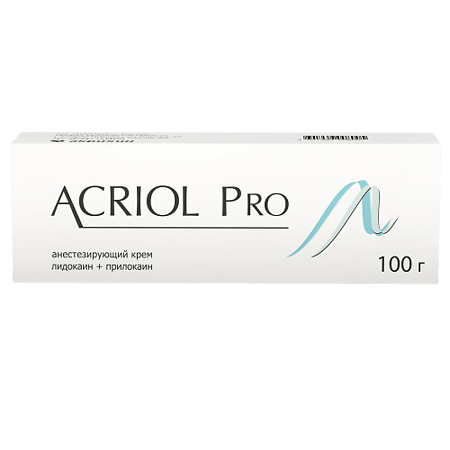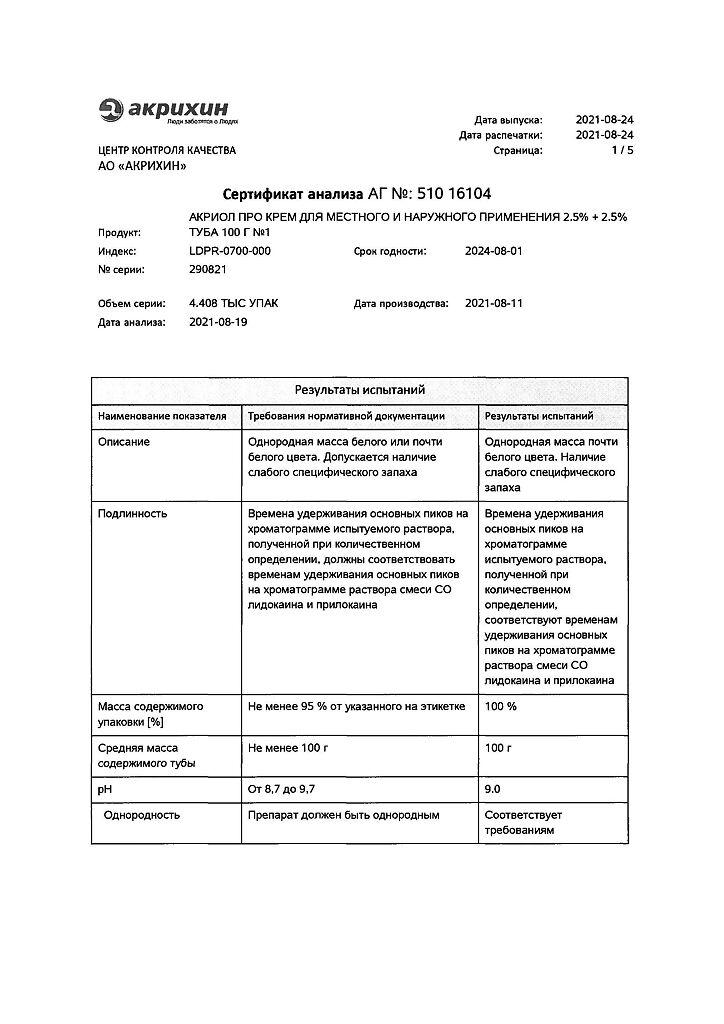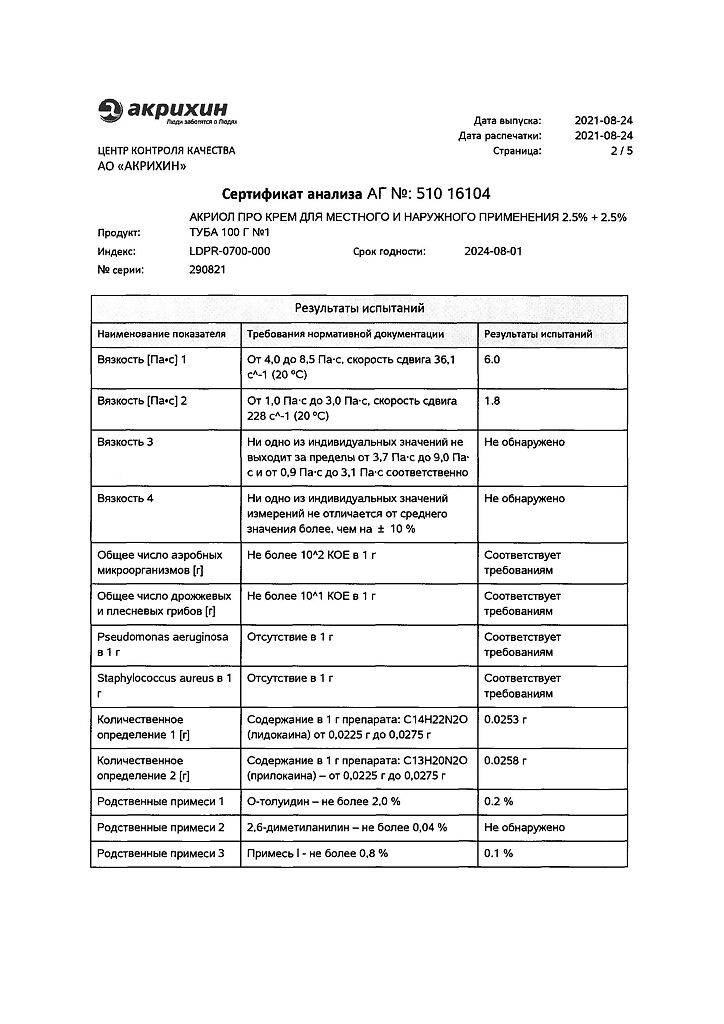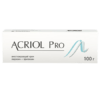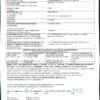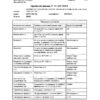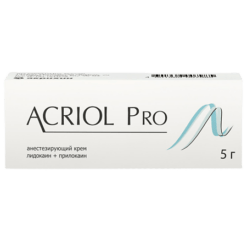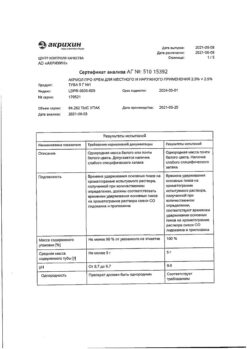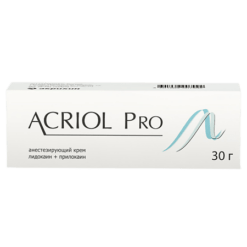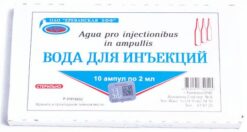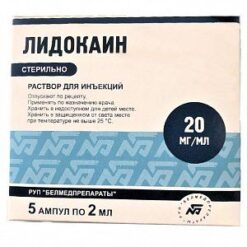No products in the cart.
Acryol Pro, cream 2.5% + 2.5% 100 g
€78.62 €65.52
EAN: 4601969008005
SKU: 280033
Categories: Anesthesia and resuscitation, Local anesthetics, Medicine
Description
Acriol Pro is a combined preparation containing lidocaine and prilocaine, local anesthetics of the amide type. Anesthesia of the skin is caused by the penetration of lidocaine and prilocaine into the layers of the epidermis and dermis. The degree of anesthesia depends on the dose of the drug and the duration of application.
Intact skin:
After application to intact skin for 1-2 hours, the duration of anesthesia after removal of the occlusive dressing is 2 hours. No differences in efficacy (including time to anesthetic effect) and safety were found when the drug was applied to intact skin in elderly (65-96 years) and younger patients.
Transient pallor or redness of the skin may occur due to the effect of the drug on superficial vessels. Patients with widespread neurodermatitis (atopic dermatitis) may show these reactions more quickly, within 30-60 minutes after application, which indicates faster penetration of the cream through the skin.
In case of puncture biopsy (4 mm in diameter), application of Akriol Pro provides adequate anesthesia of intact skin in 90% of patients in 60 minutes after needle application at a depth of 2 mm and in 120 minutes after needle application at a depth of 3 mm. The efficacy of the drug is independent of skin color or pigmentation (skin type I-IV).
. When using combination vaccines against infections such as measles, rubella, mumps, or intramuscular combination vaccines against diphtheria, pertussis, tetanus, polio and infection caused by Haemophilius influenzae type b, and hepatitis B vaccination, use of the drug had no effect on the average antibody titer, the rate at which specific antibodies appeared or disappeared in serum, or the number of patients who achieved a protective or positive antibody titer after immunization.
Genital mucosal anesthesia:
Genital mucosal anesthesia is achieved faster compared to that of intact skin due to faster absorption of the drug.
In women anesthesia is achieved in 5-10 minutes after application of the drug to the genital mucosa and is sufficient to relieve the pain caused by the use of the argon laser; the duration of anesthesia is 15-20 minutes (taking into account individual characteristics from 5 to 45 minutes).
Trophic ulcers of the lower extremities:
After application of the drug in the treatment of trophic ulcers of the lower extremities, the duration of anesthesia is up to 4 hours. No negative effects of the drug on the healing process of ulcers or with respect to bacterial flora have been noted.
Indications
Indications
In adults:
– superficial anesthesia of the skin during injections (including. in vaccinations), punctures and vascular catheterization and superficial surgical interventions, including minor cosmetic procedures and waxing;
– surface anesthesia of trophic ulcers of the lower extremities during surgical treatment (mechanical cleaning), such as for the removal of fibrin, pus and necrotic tissue;
– surface anesthesia of the mucous membrane of the genitals before painful manipulations and for pain relief before injections of local anesthetics.
In children:
– superficial anesthesia of the skin during injections (including vaccinations), punctures and catheterization of vessels and superficial surgical interventions (including the removal of molluscum contagiosum).
Active ingredient
Active ingredient
Composition
Composition
100 g of the cream contains:
Active ingredients: lidocaine – 2.5 g, prilocaine – 2.5 g.
Auxiliary substances: PEG-54 hydrogenated castor oil – 1.9 g; carbomer – 1.0 g; sodium hydroxide – 0.52 g; purified water – up to 100 g
How to take, the dosage
How to take, the dosage
Externally, on the skin or mucous membrane.
Superficial anesthesia of trophic ulcers of the lower extremities
In surgical treatment (mechanical cleaning) of trophic ulcers of the lower extremities: a single dose of about 1-2 g/10 cm2; apply the cream in a thick layer on the ulcerous surface, not more than 10 g of cream per procedure. Apply an occlusive dressing. Application time: at least 30 minutes.
The opened tube of cream is for single use, the tube with the remaining cream should be discarded after use in one patient.
If ulcers are treated where it is difficult to penetrate the tissue, the application can be extended up to 60 minutes. Mechanical cleaning should be started no later than 10 minutes after removal of the cream.
In manipulation of lower limb ulcers, the drug has been used up to 15 times over a period of 1-2 months without reducing the effectiveness and increasing the incidence of local reactions.
Superficial genital anesthesia
The skin of the genitals:
Anesthesia before local anesthetic injections:
Men: 1 g/10 cm2. Apply the cream in a thick layer to the skin. Application time: 15 min.
Women: 1-2 g/10 cm2. Apply the cream in a thick layer to the skin. Application time: 60 min.
Superficial anaesthesia of the genital mucosa:
For condyloma removal and for anaesthesia before local anaesthetic injections: approx. 5-10 g cream, depending on the surface area to be treated. The cream should be applied to the entire surface of the mucosa, including the mucosal folds. No occlusive dressing is required. Application time: 5-10 min. The procedure should be carried out immediately after removal of the cream.
Children
Anesthesia for needle insertion (incl. For vaccinations, molluscum contagiosum scraping and other minor superficial surgical procedures.
Apply the cream in a thick layer on the skin and cover with an occlusive dressing. The dosage should be appropriate for the surface to be treated and should not exceed 1 g of cream per 10 cm2.
A 3.5 cm strip of Akriol Pro is approximately the same length as the 1 g dose. Increasing the application time reduces anesthesia.
In children with atopic dermatitis the application time should be reduced to 30 minutes. Apply the cream in a thick layer to the skin and cover with an occlusive dressing.
Admonstrations for application
. Push through the protective membrane of the aluminum tube using the screw cap, squeeze a generous amount of cream from the tube, and apply to the spot of the intended application.
In case of skin anesthesia, occlusive stickers may be used. For anesthesia of trophic ulcers of the lower extremities, use a PVC occlusive dressing. Cover the dressing with the applied cream so that the layer of cream underneath is thick and does not squeeze out from under the dressing. Carefully smooth the edges of the bandage to avoid leakage of the cream.
After the recommended time, remove the bandage and any remaining cream from the surface.
Interaction
Interaction
In patients receiving drugs inducing methemoglobinemia (e.g., drugs containing sulfogroups), Akriol Pro may increase the blood concentration of methemoglobin.
When treating with other local anesthetics and structurally similar drugs (including tocainide), the risk of increased systemic effects with high doses of the drug must be considered.
Special studies to evaluate the interaction of lidocaine/prilocaine with antiarrhythmic drugs of class III were not conducted, caution should be exercised when using the drugs together.
Pharmaceutical interaction: not found.
Drugs that decrease lidocaine clearance (e.g., cimetidine or beta-adrenoblockers) may cause potentially toxic plasma concentrations when repeated high doses of lidocaine are used over an extended period of time. This interaction has no clinical significance in short-term therapy with lidocaine (including the drug Akriol Pro) in the recommended doses.
Special Instructions
Special Instructions
Patients with glucose-6-phosphate dehydrogenase deficiency or hereditary or idiopathic methemoglobinemia are more prone to drug-dependent methemoglobinemia.
The efficacy of the drug in neonates in heel blood sampling procedures has not been established.
Please use caution when applying Acryol Pro around the eyes because the drug causes eye irritation. Elimination of protective reflexes can cause irritation or damage to the cornea. If the drug gets into the eyes, immediately flush the eyes with water or 0.9% sodium chloride solution, and protect the eyes until protective reflexes are restored.
Caution should be exercised if the drug is applied to the skin in atopic dermatitis; the application time should be reduced (15-30 minutes).
In children less than 3 months of age, the safety and effectiveness of the drug were determined after a single dose application. In these children, a temporary increase in methemoglobin levels in the blood lasting up to 13 hours was often observed after application of the drug. However, the observed increase in methemoglobin levels in the blood is probably not clinically significant.
The drug should not be applied to a damaged eardrum or in other cases of possible penetration of the drug into the middle ear.
Acryol Pro should not be used on open wounds.
We do not recommend application to the mucosa of the genitals in children due to lack of data on absorption.
Lidocaine and prilocaine in concentrations above 0.5-2% have bactericidal and antiviral properties. Therefore, special care is recommended when using the drug prior to subcutaneous administration of live vaccines (e.g., BCG).
Accriol Pro is not recommended for combined use with agents causing methemoglobinemia in children from 0 to 12 months of age because of lack of data.
Contraindications
Contraindications
Hypersensitivity to local anesthetic agents of the amide type or any other component of the drug.
Perinatally premature infants born at less than 37 weeks’ gestation.
Newborns with a body weight of less than 3 kg.
With caution:
Glucose-6-phosphate dehydrogenase deficiency, hereditary or idiopathic methemoglobinemia, advanced neurodermatitis (atopic dermatitis), patients taking class III antiarrhythmic drugs (e.g., amiodarone).
Side effects
Side effects
The following adverse reactions are categorized by frequency as follows: very common (⥠1/10); common (⥠1/100, < 1/10); infrequent (⥠1/1 000, < 1/100); rare (⥠1/10 000, < 1/1 000), very rare (< 1/10 000), frequency unknown (insufficient data to estimate frequency of development).
When applied to intact skin
Skin and subcutaneous tissue disorders: Frequent – transient local reactions in the area of application, such as pallor, redness and swelling; infrequent – mild burning, itching and feeling of heat (in the area of application) in the first moment after application.
General disorders and disorders at the injection site: rarely – allergic reactions, in the most severe cases – anaphylactic shock; methemoglobinemia and/or cyanosis. Reactions in the area of application of the drug, such as hemorrhagic rash or petechial hemorrhages, especially after prolonged application in children with atopic dermatitis or molluscum contagiosum. Corneal irritation due to accidental contact of the cream in the eye.
When applied to trophic ulcers of the lower extremities
Disorders of the skin and subcutaneous tissues: often – transient local reactions in the area of application, such as pallor, redness and swelling; in the first moment after application, mild burning, itching and feeling of heat (in the area of application); infrequent – skin irritation (in the area of application).
General disorders and disorders at the place of administration: rarely – allergic reactions, in the most severe cases – anaphylactic shock.
Overdose
Overdose
The development of signs of systemic toxicity is unlikely if the recommended dosing regimen is followed.
The symptoms of intoxication are probably the same as with other local anesthetics, such as central nervous system (CNS) agitation and in severe cases CNS and cardiac depression.
In rare cases, the development of clinically significant methemoglobinemia has been noted. Prilocaine in high doses may cause an increase in methemoglobin. Superficial application of 125 mg of prilocaine for 5 hours caused the development of moderate methemoglobinemia in a 3-month-old infant. Surface application of 8.6-17.2 mg/kg lidocaine caused severe intoxication in neonates.
Treatment: Severe neurological symptoms (seizures, central nervous system depression) require symptomatic treatment, including the administration of
Because of the slow systemic absorption of the drug, patients should be monitored for several hours after the start of intoxication treatment.
Similarities
Similarities
Additional information
| Manufacturer | Akrihin HFC JSC, Russia |
|---|---|
| Medication form | exterior cream |
| Brand | Akrihin HFC JSC |
Other forms…
Related products
Buy Acryol Pro, cream 2.5% + 2.5% 100 g with delivery to USA, UK, Europe and over 120 other countries.

